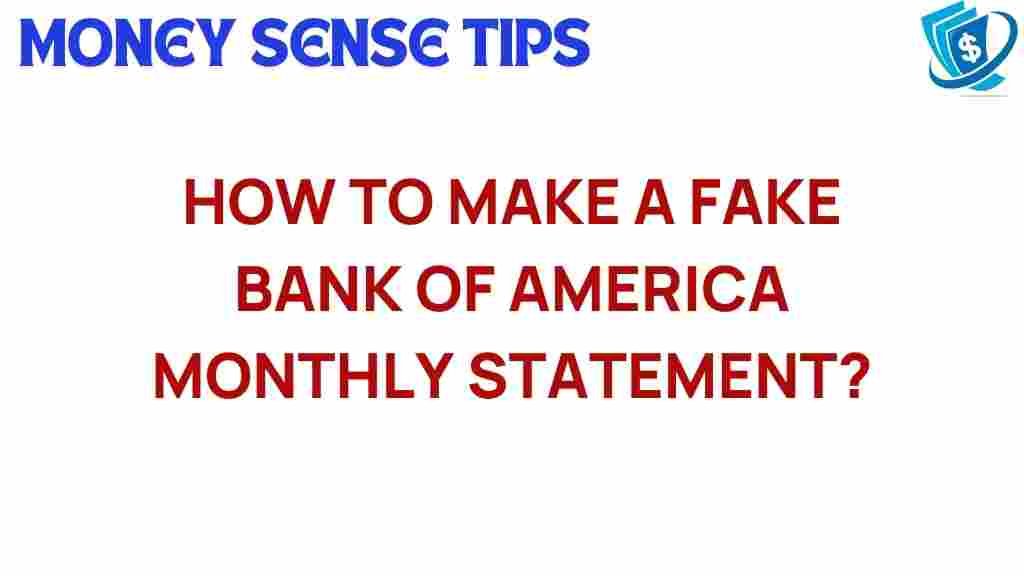Unraveling the Mystery: Crafting a Fake Bank Statement
In today’s digital age, financial documents hold significant importance. Among these, bank statements are crucial for various purposes, including securing loans, applying for housing, or verifying income. However, the darker side of document manipulation has led to the rise of fake bank statements, particularly those mimicking institutions like Bank of America. This article explores the implications of creating such fraudulent documents, delving into the realms of financial fraud, document forgery, and identity theft. We will also discuss the severe legal consequences and security risks involved, ultimately emphasizing the importance of consumer awareness.
The Allure of Fake Bank Statements
Many individuals may wonder why someone would go to the trouble of crafting a fake bank statement. The reasons can range from benign to malicious:
- Applying for loans without sufficient income
- Securing rental agreements when lacking proof of income
- Committing fraud for financial gain
While some may see it as a quick solution to their financial woes, the repercussions of such actions can be devastating.
The Process of Creating Fake Bank Statements
Understanding how fake bank statements are created can shed light on the methods used in document forgery. However, it’s crucial to note that we do not endorse or provide instructions for illegal activities. This section is purely for educational purposes, highlighting the vulnerabilities that exist.
Step 1: Gathering Information
Those who engage in crafting fake bank statements often begin by collecting personal information. This may include:
- Full name
- Account number
- Bank routing number
- Transaction history
Accessing this information can sometimes be done through hacking or phishing techniques, which are illegal and unethical.
Step 2: Using Software Tools
Various software tools and templates are available online that can assist in creating realistic-looking bank statements. These tools often allow users to input personal information and generate documents that appear legitimate. However, using these tools poses several security risks, including exposure to malware and potential legal action.
Step 3: Printing and Modifying
Once the document is created, it may be printed on paper that resembles that used by Bank of America. Further modifications can include:
- Adding logos and watermarks
- Altering fonts and colors
- Creating fake transaction entries
These enhancements aim to deceive the recipient into believing the document is authentic, but they can be easily detected with scrutiny.
Troubleshooting Common Issues
Individuals attempting to create a fake bank statement may encounter several issues:
- Document Authenticity: Many institutions have strong measures to verify the authenticity of financial documents.
- Legal Ramifications: If caught, the consequences can include hefty fines and imprisonment.
- Security Risks: Engaging in such activities can expose personal data to cybercriminals.
These challenges highlight the precariousness of adopting illegal methods for financial gain.
Legal Consequences of Forging Bank Statements
The act of creating a fake bank statement falls under financial fraud and document forgery. Legal ramifications can be severe and can include:
- Criminal charges that may lead to imprisonment
- Heavy financial penalties
- Restitution payments to victims of fraud
In the United States, federal laws regarding fraud can result in serious penalties, including lengthy prison sentences.
Identity Theft and Its Implications
Creating a fake bank statement can also result in identity theft. If personal information is acquired without consent, it can lead to further fraud or misuse, including:
- Opening accounts in the victim’s name
- Accumulating debt without the victim’s knowledge
- Damaging the victim’s credit score
Identity theft is a serious crime and can take years for victims to recover from, both financially and emotionally.
Security Risks Associated with Fake Bank Statements
There are substantial security risks tied to the creation and use of fake bank statements:
- Data Breaches: Personal information can be hacked or sold on the dark web.
- Fraudulent Transactions: Using fake documents can lead to unauthorized transactions and loss of funds.
- Criminal Investigation: Engaging in fraudulent activities can attract law enforcement scrutiny.
These risks often outweigh any perceived benefits of using fake documents.
Enhancing Consumer Awareness
Understanding the dangers associated with fake bank statements is crucial for consumer awareness. Here are ways to protect oneself:
- Verify Document Authenticity: Always check the legitimacy of documents presented for financial transactions.
- Educate Yourself: Learn about the signs of fraud and how to protect your personal information.
- Report Suspicious Activity: If you suspect fraud, contact your bank and report it immediately.
For more information on preventing identity theft, visit the Federal Trade Commission’s website.
Conclusion
The allure of creating a fake bank statement may seem tempting for some, but the risks and consequences far outweigh any short-term benefits. Engaging in financial fraud not only jeopardizes individual freedom and finances but also contributes to broader societal issues such as document forgery and identity theft. It is crucial for consumers to be aware of the implications of such actions and to prioritize ethical behavior over deceitful shortcuts.
Ultimately, fostering a culture of honesty and transparency in financial dealings will lead to a more secure and trustworthy environment for everyone.
This article is in the category Security and created by MoneySenseTips Team
